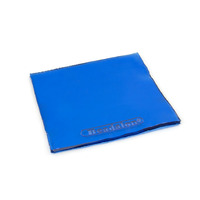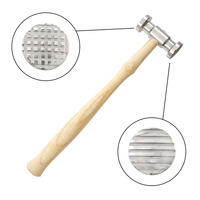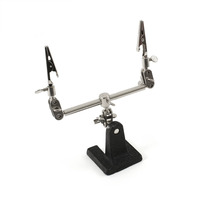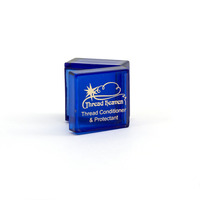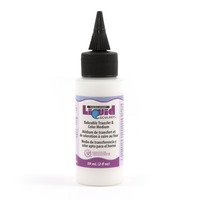Beader’s dictionary
T
TEXTURING HAMMER (See products)
Tool used to hammer metal wires and obtain different textures. It is made with two textured ends that imprint patterns in metal wires when hammered. One side allows for a squared pattern and the other a lined/ribbed pattern. Use it with soft metal wires like aluminum. A wire of bigger caliber offers a better rendering of the pattern.
THAI SILVER
Over the past decades, Thai artisans have built a great reputation because of their silver creations. While using rudimentary techniques and equipment, they manage to make uniquely styled parts.
Thai silver is made of fine silver. It is not an alloy. Thai silver coins are formed by hammering or forging. The carved patterns are often inspired from nature.
THIRD HAND
Third hand or helping hand, this tool has two crocodile clips which hold objects and allow hands to be free, thus to work freely. The stand has several joints that can modify the alignment of several of its elements. This stand is very useful for tasks such as painting a small room, collages, welding or assembling.
THREAD BURNER (See products)
The Thread Zap II tool is a precision tool used to burn string ends. It consists of a thin extremity made from a metal string that vehicles heat when we press on a button. The heat then burns the string and cuts it. Its thin end allows for an even cut on strings, near the knot for example, where the scissors cannot reach. The thread burner tool can be used with different types of strings, such as silk strings, cotton strings and nylon strings (WildFire, K.O., FireLine, etc.). It is often used to finish a seed bead weaving as it hides the string ends. The extremity of the tool is fragile, which is why it is recommended to avoid putting pressure on the end and to put the cap back on between each use. Additional ends are sold separately. This tool functions using AA batteries that are not included in the package.
THREAD PROTECTOR WAX
Wax for strings of low caliber, notably weaving strings. The wax prevents the strings from fraying. It is also used to facilitate threading and prevent any knots from forming. This non-greasy wax is very effective on strings made of silk, nylon, cotton, linen and delicate metal stings. Simply slide the strings on the wax and remove any excess by sliding the strings between fingers.
TIGER EYE
Tigers eye is an opaque stone that comes from the yellow gold to brown quartz family, it is characterized by its chatoyancy; a rippling chatoyant reflection. Its color can be attributed to iron. Its name is derived from the fact that when cut in cabochon, the chatoyancy of the stone recalls that of the similarly named feline. Tigers eye can be painted in any color just like the red tigers eye. Deposit are found mostly in South Africa, Australia, Myanmar, in The United-States, In India as well as in Namibia.
TIGERTAIL
Tigertail is the name of a metal wire that is made of several strands of stainless steel that are more or less thin. The strands are coated in nylon, colored dyed or not. This kind of wire is often used to string beads, to hang or make multi-row necklaces or bracelets without the use of a needle. Crimp beads are indispensable to make a jewel with this kind of wire as tigertail cannot be tied.
The wire that is made using 49 strand is the most flexible. Made with 49 tiny strands that are twisted, which provides it with an excellent flexibility and improves it resistance to dents.
The wire that is made using 19 strands has a good flexibility and a resistance to dents that is notable.
The wire that is made using 7 strands is the standard wire, it is the most commonly used. It is a relatively flexible wire that has a low resistance to dents. However, it can withstand heavier beads with more ease and is very affordable.
There is now a wire that is fully resistant to dents. From the maker Beadalon, the “kink Free Ti” is made with titanium rather than the conventional stainless steel. It cannot be folded as it will always return to its original shape. It is presently only available in one size : 0.021 inches (0,53 mm).
It is important to choose the type of Tigertail according to the needs of the jewelry piece. The weight of the beads, as well as the flexibility required for its design and the manipulations needed for its conception are all important aspects to take into consideration when choosing the type of string.
There is a great variety of colors available for the nylon covered stainless steel wire. It can be found in its natural color (steel), in other metal colors (copper, bronze, gold and silver) and also in a multiplicity of other, clear, opaque and glossy. it can also be found in silver or gold plated as well as sterling silver.
The wire is available in several sizes ranging from 0.012 to 0.026 inches, the most commonly used being 0.018. However, some manufacturers measure it in millimeters. Please refer to the Diameter and charge table for the conversion.
Insert the table
Tigertail’s price varies depending on its origin and the number of strands (7, 19 or 49), the wire’s caliber and the plating.
TITANIUM
Titanium is a very rare and onerous white metal. It is light and resistant. it has an amazing resistance to corrosion, heat, intense cold, and a good ductility (the ability for metals to be transformed into strings and be stretched without breaking). Its coloration capacity makes it a prized metal in the jewelry industry since the 1980’. Titanium’s coloration is obtained by a anodic oxidation (oxigraphy); this specific metal then produces a thin layer of colored oxide. The length of time exposed and the intensity of the electric current determine the color of the oxidation. With this process, dark blues to silvery grays as well as yellows and bright pink are obtained.
TRANSFER MEDIUM
The liquid translucent medium is very versatile and can be used for various art/craft projects. It can be used to do an image transfer, to add colors, to glue or varnish.
To make an image transfer, apply a thin layer of the medium on the chosen image and bake it for 15 to 30 minutes at 130°C. Then, remove the image from the stove and submerge it in water for about 5 minutes. Carefully rub the paper to delicately remove it and only keep the image transfer.
For a touch of color, add a small amount of pigment into the liquid to color it.
It can also be used as an adhesive. However it needs to be cooked first for that.
It can also be used as a varnish.
TURQUOISE
Turquoise is an ornamental stone of an opaque blue-green, sky blue and apple green color. It is a phosphate hydrated with copper and aluminum. Its blue tones are attributed to the presence of copper, while its shades of green are relevant to the presence of iron. Its name means "stone of Turkey", as it initially transited for commerce through Turkey at the time of the Crusades. This is where the turquoise stone (in its shade of blue) takes its name. The designation “turquoise matrix” is given to turquoise stones streaked with brown, gray or black veins. Turquoise is often cut into cabochons, beads or carved to make statues or decorative objects.
Turquoise has been mined for a very long time, and a number of deposits are now exhausted. It has been extracted from Iran for at least 2000 years. There is also turquoise jewelry found in Egypt (first dynasty of pharaohs) issued from deposits in Sinai. The said deposits were exploited 4000 BC and are now exhausted. It is now issued from Iran, Afghanistan, Argentina, Australia, Brazil, the United States, China, Mexico, Israel and Tanzania (amongst others).
Sometimes the turquoise can tarnish or change color due to exposure to light, perspiration, oils, cosmetics or loss of its natural moisture. It it is then said to be "dead."
The porous turquoises are stabilized, in other words, they are covered with resin, wax or plastic to be consolidated. Their color can be improved using dyes, copper salts, oil or paraffin.
A reconstituted turquoise can be made of the stone powder agglomerated with a black plastic design and as such, it mimics the "turquoise matrix" with its brown to black veining.
Magnesite, chalcedony and howlite can easily be colored blue to replicates turquoises. There are also many imitations: turquenite, neolite, Viennese turquoise, glass, plastic, porcelain, etc.
TWEEZERS WITH SHOVEL (See products)
Long narrow sharp tweezers with spring. It allows to pinch and pick up small objects such as seed beads. It can also be used to dislodge strings that are stuck in a weaving piece or to hold a small element on which glue is being applied. This tool is also equipped with a shovel to easily pick up small beads that can slip through your fingers, which is why it’s also called tweezers with shovel.






